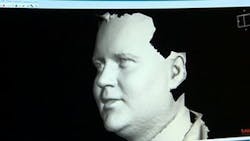3D facial scanners aid in facial surgery, dental procedures
Scientists from Cardiff University are using 3D scanners from 3dMD to collect data from a patient’s face and create 3D models that will enhance a surgeon’s ability to perform customized surgery.
3dMD’s system works by converting images from three cameras into a moving 3D model of a patient’s head, according to Techworld. Cardiff University is already using the 3D technology to help surgeons treating people who need surgery. Dr. Hashmat Popat, consultant orthodontist at Cardiff says that the system provides data that ordinary video cannot.
“Research into facial movement has important applications in patients whose facial movement is affected by conditions such as a cleft lip, neurological conditions such as Parkinson’s disease or someone who has experienced a stroke,” he said in a press release.
“Videos have generally been the preferred method for recording facial movements – unfortunately, they are only-two dimensional so when analyzing how the face moves, important data is lost,” he added.
In an interview with Techworld, Professor David Marshall of Cardiff University’s computer science and informatics department said that the system draws on two video feeds at slightly different angles to create a 3D geometric model of a person’s face. These feeds are positioned at slightly different angles and an algorithm is used to match points on each image frame to corresponding points on another. A third feed determines the visual texture of the face.
Moving forward, the team says that the technology could be used in the future to develop a suite of software tools for dental analysis and more general computer science-based applications, according to Marshall.
“We have long term plans to commercially develop the technology,” he said. “Currently the market is small as 3D dynamic systems but we expect this technology to expand greatly in the coming years and find new markets.”
View the press release.
View the Techworld article.
Also check out:
How 3D visualization software could be used to help treat injured soldiers
Five interesting applications of 3D scanning
3D scanners used to create zombies in World War Z
Share your vision-related news by contacting James Carroll, Senior Web Editor, Vision Systems Design
To receive news like this in your inbox, click here.
Join our LinkedIn group | Like us on Facebook | Follow us on Twitter
About the Author

James Carroll
Former VSD Editor James Carroll joined the team 2013. Carroll covered machine vision and imaging from numerous angles, including application stories, industry news, market updates, and new products. In addition to writing and editing articles, Carroll managed the Innovators Awards program and webcasts.
